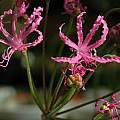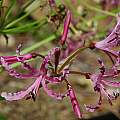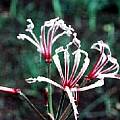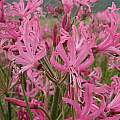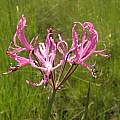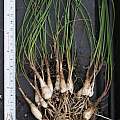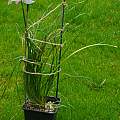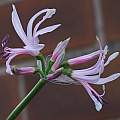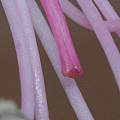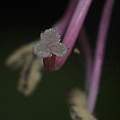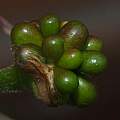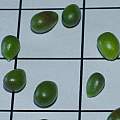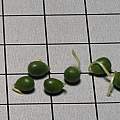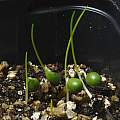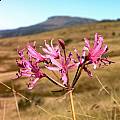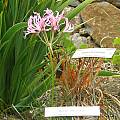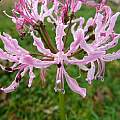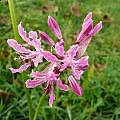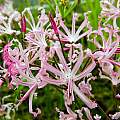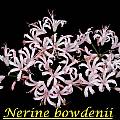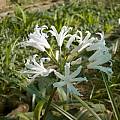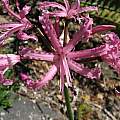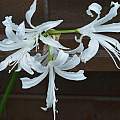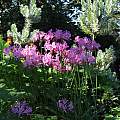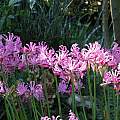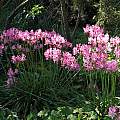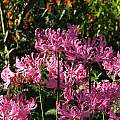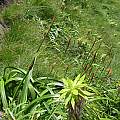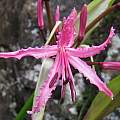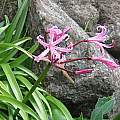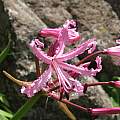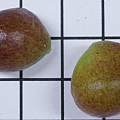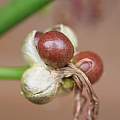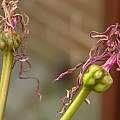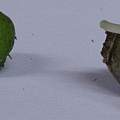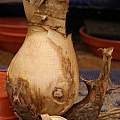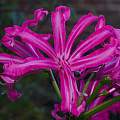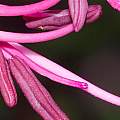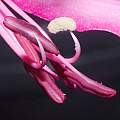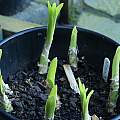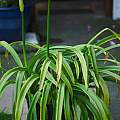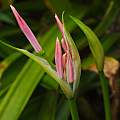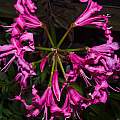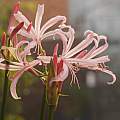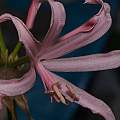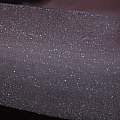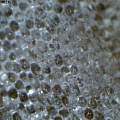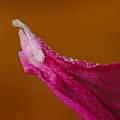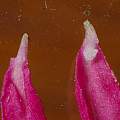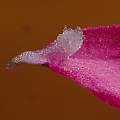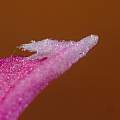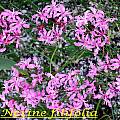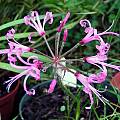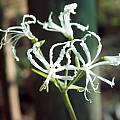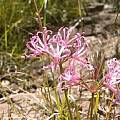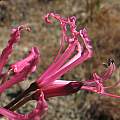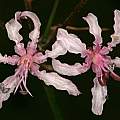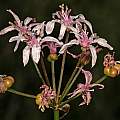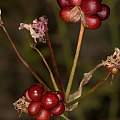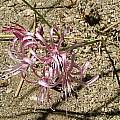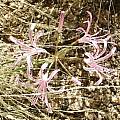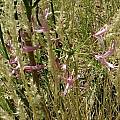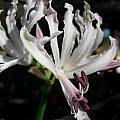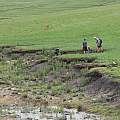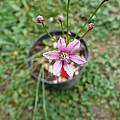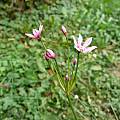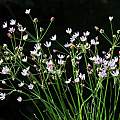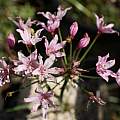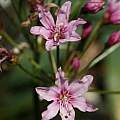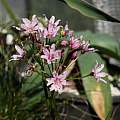Nerine is a genus of 25 species in the family Amaryllidaceae 21 of which are endemic to the geographic areas of South Africa, Lesotho and Swaziland. The other 4 occur throughout southern Africa. Only 4 species are winter growing and 21 are summer growing, a subset of which are evergreen. Graham Duncan's Grow Nerines and The Amaryllidaceae of Southern Africa are good resources. In cultivation, Nerine has been widely hybridized. See Nerine Hybrids for photos of hybrids.
Information and photographs illustrating Nerine species A-G can be found on this page.
Nerine alta W.F.Barker see Nerine undulata
Nerine angustifolia (Baker) W.Watson is native to the summer rainfall areas of Lesotho, Swaziland and South Africa (KwaZulu-Natal, Free State, former Cape Province, and former Transvaal) where it occurs on flats and montane habitats in acid grassland marshes, often in large colonies. It is usually evergreen in cultivation when grown in mild climates or in the greenhouse, but in nature is dormant during the winter and spring. The plants range from 30 cm (1 foot) to 1 m (3 feet) and have up to six slightly channeled, linear leaves and pink flowers with wavy margins in the upper half, and recurved tips. Photos 1-2 are from Mary Sue Ittner who grows it in coastal Northern California in a container where it is sheltered a bit in winter from the rain. Grown from seed, it blooms reliably every fall. Photos 3-6 are from Cameron McMaster. Photo 3 is of a Mpumalanga form grown in the garden. Photos 4-5 are habitat pictures taken in Lady Grey, and photo 6 was taken near Ugie, Maclear, Eastern Cape.
The first photograph below shows bulbs two years after the seed was sown (in June 2009). The bulbs have survived being a couple of degrees below freezing i.e. in pots on a shelf in the air, and flowered in August 2012; they have been evergreen. The second photograph shows flowering plants in a 4" high pot. The style continues to develop after the flower opens and it reaches the pollen receptive form in photo five after about a week; compare with the initial form in photo four. Photographs by David Pilling.
Photographs from David Pilling of ripening seed, seed and germinating seed both on a 10 mm grid. Photo 4 is of the resulting seedlings a week after photo 3.
The next two photos are of Nerine angulata, now included under Nerine angustifolia. Photo #1 was taken by Cameron McMaster in situ near Somerset East. Photo #2 was contributed by the UC Botanical Garden.
Nerine appendiculata Baker is native from the marshy, summer rainfall areas of East Cape Province to the middle and southwestern KwaZulu-Natal. It is usually found in large colonies and blooms from December to the end of April (summer-fall). This species has deeply channeled linear leaves. The flowers have long white appendages at the base of the stamens and a many flowered inflorescence of pink flowers. It is best grown in full sun with the top of the neck of the bulbs just below the soil and well spaced heavy watering in summer and less water in winter. It often remains evergreen in cultivation. The final photo is of a plant grown from Silverhill seed, flowering in late August in the UK. Photos by Alessandro Marinello and Tom Mitchell.
Nerine bowdenii W.Watson is native to the summer growing regions from East Cape Province, Free State and KwaZulu-Natal. It is named after Athelstan Hall Cornish-Bowden, a British born surveyor in South Africa, who sent bulbs back to England in 1899. Flowering occurs late in the season (fall), mostly in shades of pink. It is very hardy in cold climates and is popular for cut flowers. Its hardy nature is said to be a result of it growing in the Drakensberg mountains. Plants left undisturbed will multiply into many bulbs and bloom most spectacularly in the ground provided they get summer water. It is reported that this species matures from seeds in 5-6 years but can take as long as 9 years or more depending on growing conditions and disturbance (Jim Shields, Mark Mazer). Photo 1 was taken by Bill Dijk. Photo 2 was taken by Cameron McMaster of a white form. Photo 3 by Nhu Nguyen shows a closeup of the flower taken at the UC Botanical Garden. Photo 4 by David Pilling shows the commercially available cultivar 'Alba' flowering in North West England in November.
Photos by Nhu Nguyen of some beautiful blooming clumps photographed at the Strybing Arboretum, San Francisco. Photo 1 shows the plants in front of some young silver trees, Leucadendron argenteum, another South African native.
Photos taken in habitat by Cameron McMaster at Sentinel Peak in the Eastern Cape. In the first photo the plants are in bud. Also in the photo is an Eucomis bicolor in the foreground.
All of the photographs below were taken by David Pilling. The first is of seed on a 5 mm grid in November in North West England. It is typical of fleshy amaryllid seed, being ephemeral (recalcitrant) and unsuitable for drying. For propagation it can be kept moist at room temperature and will germinate a few weeks after harvesting as shown in the next to last picture. Keeping seed dry will not stop it germinating. The coin shown with the bulb is about an inch in diameter.
Flowers usually have six petals, six anthers and one style. Both the anthers and the style change after the flower opens. The first photo shows a flower with seven petals and anthers, the second shows the undeveloped style, the third shows it when pollen receptive, and the final photo shows anthers in three states.
The next photos show leaves emerging (23rd February 2012), scapes (8" high black pot) and the typical umbel of perhaps 12 flowers that may appear at the top of them (same pot as in the first photo mid October 2012).
These photos show a pale pink variety, in the first one the light is weak and diffuse; the next two photos are taken with a small intense light source and the flower appears to sparkle. A comparison might be made with the 'diamond dust' associated with Nerine sarniensis hybrids. The final photo is at high magnification (total width about 1 mm) and shows the source of the sparkling is tiny.
The tips of the petals have "cohering keels" which are structures that keep the flowers closed until fully developed. It is common to find petals locked together; the first photo shows two such petals; the second photo shows them separated. The final two photos are details of petal tips. For more information on this subject see the entry for Amaryllis belladonna.
Nerine falcata W.F.Barker has had a confusing history. It was published in 2016 as Nerine krigei ssp. falcata (W.F.Barker) G.D.Duncan.
Nerine filifolia Baker is native to the summer rainfall area of the East Cape, Free State, Swaziland and Mpumalanga where it is found growing in rock outcrops. This summer growing species is probably the most prolific and best known of the low growing species, and one that is deservedly popular as a border plant. The grassy almost evergreen foliage is thin and slender while the numerous flower scapes 6-9 in (14-22 cm) tall carry 8-10 small spidery light rosy-red flowers, freely produced during autumn. Photo 1 was taken by Bill Dijk and photo 2 was taken by Lee Poulsen August 2003. Photos 3-4 were taken by Cameron McMaster. Photo 3 is of a white form and photo 4 is of a pink form in habitat. Photo 5 was taken by Nhu Nguyen at the UC Botanical Garden in October 2008.
Nerine flexuosa (Jacq.) Herb. see Nerine undulata
Nerine frithii L.Bolus is a summer growing species native to the Free State, former Transvaal, and former Cape Provinces. It is variable enough where it can be deciduous or evergreen. The leaves are filiform and can grow up to 15 cm (6 inches) long. The white to light pink flowers are widely spreading and recurved with deep pink or maroon bases. Margins can be slightly to strongly undulate. Photos taken in seasonally wet grassland on limestone in northwest South Africa by SAplants shared under a CC BY-SA 4.0 license.
Nerine gaberonensis Bremek. & Oberm. is a summer growing species native to southeastern Botswana and South Africa (Northern Cape Province and former Transvaal). Plants can be found in colonies between limestone cracks and granite outcrops or deep red sand dunes. They go completely dormant in the winter. Plant the bulbs with their necks just above soil level and give them full sun. In harsher sun areas, give the plant full morning exposure and afternoon shade. In plastic containers, water well once every 10 days in the summer growing season and once a month in the winter. The bulbs can also be kept completely dry during this rest period. In a good medium, no supplementary fertilizer is necessary because that will cause leaf growth in expense of flowers. Plants grown from seeds will often bloom in the third year of growth (Duncan 2002). The photos below were taken in habitat at the Augrabies falls (Northern Cape) by Christiaan van Schalkwyk.
Nerine gibsonii K.H.Douglas is a very rare summer growing species from the Eastern Cape and former Transkei. It occurs along stream banks in wet acid grassland soil between 1500-1700 m. Because of where it occurs, it needs frequent water in cultivation, especially when in active growth from early summer to mid autumn. Plants die back briefly in mid-winter. The leaves are filiform with umbels containing 4-9 flowers. Photos by Cameron McMaster including the second habitat shot.
Nerine gracilis R.A.Dyer is a summer growing species native to southern Mpumalanga Province (northeast South Africa) where it occurs in damp depressions in shallow soil over rock sheets. It is a short species suitable for container cultivation with thread like leaves (up to 30 cm) and pale pink or rose pink flowers with wavy margins and green keels on the lower surface. In the wild it is dormant in winter, but in cultivation often retains its leaves. In colder climates it should be allowed to dry out in winter. Photos 1-2 were photographed by Alessandro Marinello. The last photo from Bert Zaalberg.
Photos below were taken by Nhu Nguyen.
